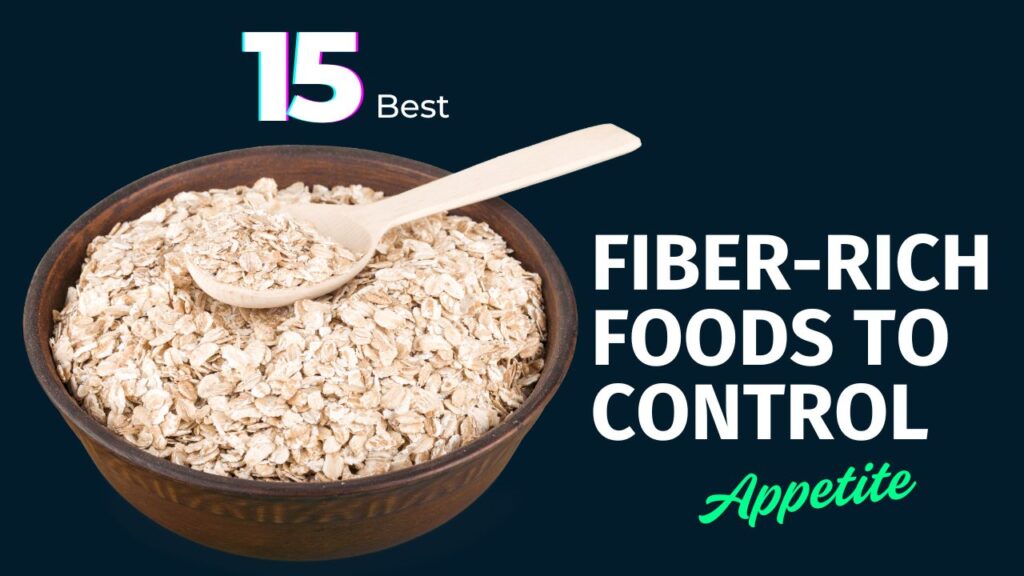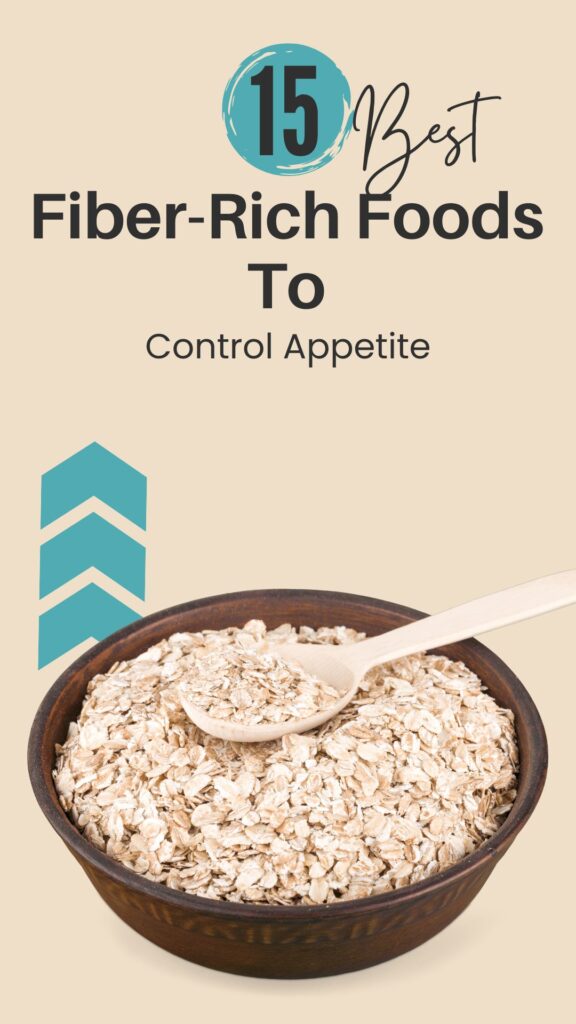Some links in this post are affiliate links. If you make a purchase through these links, I may receive a small commission. This helps support the site at no extra cost to you.
Have you ever eaten a big meal only to feel hungry again within an hour? That’s often because the foods we choose are low in fiber.
Fiber is the secret weapon for lasting fullness, balanced digestion, and weight management. Unlike carbs and fats that break down quickly, fiber slows down digestion, stabilizes blood sugar, and helps you feel satisfied longer.
Do you know that most adults consume only half the recommended daily fiber? The average intake hovers around 15 grams per day, while experts suggest 25–38 grams for optimal health.
This fiber gap may be the reason many people constantly battle cravings, overeating, and mid-afternoon energy slumps.
In this post, we’ll explore 15 fiber-rich foods that naturally control appetite, along with practical ways to add them to your diet, storage tips, and precautions. By the end, you’ll know exactly how to eat smarter, not less, to feel fuller and healthier.

Table of Contents

15 Best Fiber-Rich Foods To Eat
1. Oats
Best Ways to Eat or Use It
- Morning oatmeal topped with nuts or berries
- Overnight oats soaked with chia seeds
- Added to smoothies for thickness
Who Should Eat / Avoid
- Good for: weight-loss seekers, athletes, those with high cholesterol
- Avoid/Limit if: you have gluten intolerance (choose certified gluten-free oats)
Storage & Buying Tips
- Buy steel-cut or rolled oats (less processed than instant)
- Store in airtight jars in a cool, dry pantry
Do’s & Don’ts
✅ Do: add protein (like Greek yogurt) for better satiety
❌ Don’t: overload with sugar or flavored instant packets
Possible Side Effects
- Excess can cause bloating if your body isn’t used to high fiber
2. Apples
Best Ways to Eat or Use It
- Snack on raw slices with nut butter
- Add chopped apples to salads
- Bake with cinnamon for a dessert substitute
Who Should Eat / Avoid
- Good for: people with sugar cravings, kids, office workers needing a light snack
- Avoid/Limit if: you have irritable bowel syndrome (some may be sensitive to fructose)
Storage & Buying Tips
- Choose firm apples with no soft spots
- Refrigerate to extend freshness up to 2–3 weeks
Do’s & Don’ts
✅ Do: eat with the skin (most fiber is there)
❌ Don’t: peel off the skin unless necessary
Possible Side Effects
- May cause mild gas in sensitive individuals due to natural sugars
3. Lentils
Best Ways to Eat or Use It
- Cook into soups or stews
- Toss into salads for extra protein
- Use as a meat substitute in curries or tacos
Who Should Eat / Avoid
- Good for: vegetarians, pregnant women (rich in folate), weight-loss diets
- Avoid/Limit if: you have gout (due to purine content)
Storage & Buying Tips
- Buy dry lentils in bulk; store in airtight containers
- Cooked lentils last 4–5 days in the refrigerator
Do’s & Don’ts
✅ Do: soak lentils before cooking to improve digestibility
❌ Don’t: overcook, as they can become mushy
Possible Side Effects
- May cause gas if eaten in excess without soaking
4. Chia Seeds
Best Ways to Eat or Use It
- Mix into smoothies
- Make chia pudding with milk/plant milk
- Sprinkle over salads or yogurt
Who Should Eat / Avoid
- Good for: athletes, dieters, those with diabetes (helps blood sugar control)
- Avoid/Limit if: you have swallowing difficulties (seeds absorb water and swell)
Storage & Buying Tips
- Store in airtight jars; they last up to 2 years
- Buy organic, if possible, to avoid pesticide exposure
Do’s & Don’ts
✅ Do: soak chia before eating for better digestion
❌ Don’t: eat large amounts dry
Possible Side Effects
- Excess can cause constipation if not paired with enough water
5. Broccoli
Best Ways to Eat or Use It
- Lightly steam and season
- Roast with olive oil and garlic
- Add raw florets to salads
Who Should Eat / Avoid
- Good for: women’s health (rich in folate and vitamin C), immune-boosters
- Avoid/Limit if: you have thyroid issues (limit raw cruciferous intake)
Storage & Buying Tips
- Choose firm, green heads with no yellow spots
- Refrigerate in a perforated bag, lasts 4–5 days
Do’s & Don’ts
✅ Do: lightly steam to preserve nutrients
❌ Don’t: overcook (destroys vitamin C and fiber quality)
Possible Side Effects
- May cause gas due to sulfur compounds
6. Quinoa
Best Ways to Eat or Use It
- Cook as a base for grain bowls
- Add to soups and salads
- Use instead of rice
Who Should Eat / Avoid
- Good for: vegetarians (complete protein), active people
- Avoid/Limit if: kidney patients need to monitor protein intake
Storage & Buying Tips
- Rinse before cooking to remove bitterness
- Store dry quinoa for months in airtight jars
Do’s & Don’ts
✅ Do: combine with vegetables for balanced meals
❌ Don’t: skip rinsing (saponins can cause stomach upset)
Possible Side Effects
- Rare allergies, but mostly safe
7. Sweet Potatoes
Best Ways to Eat or Use It
- Bake whole and eat as a side dish
- Mash with herbs as a healthier potato substitute
- Slice thin for baked fries
Who Should Eat / Avoid
- Good for: athletes (natural energy source), those with sugar cravings
- Avoid/Limit if: you have kidney issues (potassium content)
Storage & Buying Tips
- Keep in a cool, dark place (not refrigerator)
- Use within 1–2 weeks
Do’s & Don’ts
✅ Do: eat with the skin for maximum fiber
❌ Don’t: deep fry
Possible Side Effects
- May raise blood sugar if eaten in excess by diabetics
8. Pears
Best Ways to Eat or Use It
- Fresh, with skin on
- Poached with spices
- Diced into yogurt or cereal
Who Should Eat / Avoid
- Good for: digestive health (natural sorbitol)
- Avoid/Limit if: sensitive to high FODMAP foods
Storage & Buying Tips
- Buy slightly firm pears; ripen at room temp
- Refrigerate once ripe
Do’s & Don’ts
✅ Do: eat ripe pears for better sweetness
❌ Don’t: peel off skin unnecessarily
Possible Side Effects
- May cause loose stools if overeaten
9. Carrots
Best Ways to Eat or Use It
- Snack raw with hummus
- Add grated carrots to salads or stir-fries
- Roast with spices
Who Should Eat / Avoid
- Good for: kids, eye health, weight management
- Avoid/Limit if: prone to kidney stones (oxalates)
Storage & Buying Tips
- Store in fridge in a perforated bag
- Trim greens to prevent moisture loss
Do’s & Don’ts
✅ Do: pair with olive oil for better absorption of beta-carotene
❌ Don’t: leave cut carrots uncovered (they dry out)
Possible Side Effects
- Overeating may lead to “carotenemia” (orange-tinted skin)
10. Beans (Black, Kidney, etc.)
Best Ways to Eat or Use It
- Make bean salads
- Blend into soups for thickness
- Use in wraps or tacos
Who Should Eat / Avoid
- Good for: vegetarians, athletes, weight-loss diets
- Avoid/Limit if: digestive sensitivities (gas, bloating)
Storage & Buying Tips
- Buy dry beans and soak overnight before cooking
- Store cooked beans in fridge up to 4 days
Do’s & Don’ts
✅ Do: cook thoroughly to reduce anti-nutrients
❌ Don’t: eat undercooked beans (toxic compounds)
Possible Side Effects
- Excess can cause bloating
11. Berries (Blueberries, Raspberries, Strawberries)
Best Ways to Eat or Use It
- Add to smoothies or yogurt
- Eat fresh as snacks
- Use in oatmeal
Who Should Eat / Avoid
- Good for: heart health, diabetics (low GI fruits)
- Avoid/Limit if: you have berry allergies
Storage & Buying Tips
- Refrigerate and wash just before eating
- Freeze for long-term storage
Do’s & Don’ts
✅ Do: eat fresh for max antioxidants
❌ Don’t: leave at room temperature too long
Possible Side Effects
- Rare allergies; excess can cause stomach upset
12. Barley
Best Ways to Eat or Use It
- Cook into soups
- Use as a base for salads
- Replace rice in meals
Who Should Eat / Avoid
- Good for: cholesterol reduction, weight management
- Avoid/Limit if: gluten sensitivity
Storage & Buying Tips
- Store in airtight jars in pantry
- Use within 6 months for best freshness
Do’s & Don’ts
✅ Do: soak before cooking for better texture
❌ Don’t: eat raw barley
Possible Side Effects
- Can cause bloating in sensitive stomachs
13. Avocado
Best Ways to Eat or Use It
- Mash into guacamole
- Spread on whole-grain toast
- Add slices to salads
Who Should Eat / Avoid
- Good for: heart health, athletes, those on keto diets
- Avoid/Limit if: kidney issues (potassium)
Storage & Buying Tips
- Buy firm, ripen at room temperature
- Store ripe avocados in fridge to slow ripening
Do’s & Don’ts
✅ Do: add lemon juice to prevent browning
❌ Don’t: leave cut avocado uncovered
Possible Side Effects
- High calorie; overconsumption may hinder weight loss
14. Flaxseeds
Best Ways to Eat or Use It
- Grind and add to smoothies
- Sprinkle on cereal or yogurt
- Mix into baked goods
Who Should Eat / Avoid
- Good for: women’s health (phytoestrogens), heart health
- Avoid/Limit if: hormone-sensitive conditions (consult doctor)
Storage & Buying Tips
- Always store ground flax in refrigerator
- Buy whole seeds and grind fresh for nutrients
Do’s & Don’ts
✅ Do: grind before eating (better absorption)
❌ Don’t: eat whole (passes undigested)
Possible Side Effects
- Excess may cause diarrhea
15. Popcorn (Air-Popped)
Best Ways to Eat or Use It
- Air-pop and season lightly with herbs
- Avoid butter-heavy microwave versions
- Mix with nuts for a fiber-rich snack mix
Who Should Eat / Avoid
- Good for: movie snackers, dieters (low-calorie)
- Avoid/Limit if: diverticulitis flare-ups
Storage & Buying Tips
- Store kernels in airtight jars
- Pop only as much as you need
Do’s & Don’ts
✅ Do: season with herbs or spices
❌ Don’t: drown in butter or sugar
Possible Side Effects
- Excess salt or butter negates health benefits
Conclusion
Fiber isn’t just about digestion—it’s about energy, satiety, and long-term health. These 15 fiber-rich foods are simple to include in your daily meals, from snacks like apples and popcorn to hearty dishes with lentils or quinoa. They help control appetite, reduce cravings, and keep your body fueled for longer.
Start by adding one or two of these foods today—sprinkle flaxseeds on your breakfast, enjoy a pear at lunch, or swap rice for quinoa at dinner. Over time, you’ll notice better digestion, fewer hunger pangs, and a natural boost in overall wellness.
Which of these fiber-rich foods will you try first? Share your favorite recipe or snack idea in the comments!
Frequently Asked Questions (FAQs)
How much fiber do I need daily?
Most adults need 25–38 grams of fiber per day, depending on age and gender. Unfortunately, many people only get about half of that.
Can fiber really help with weight loss?
Yes. Fiber slows digestion, increases satiety, and helps control appetite, making it easier to manage calorie intake naturally.
Are fiber supplements as good as natural fiber?
Supplements (like psyllium husk) can help but shouldn’t replace whole foods, since foods also provide vitamins, minerals, and antioxidants.
Can eating too much fiber be harmful?
Yes. Overeating fiber suddenly can cause bloating, gas, constipation, or diarrhea. It’s best to increase fiber gradually and drink plenty of water.
Which fiber-rich foods are best for quick snacks?
Apples, pears, carrots, air-popped popcorn, and chia pudding are easy, on-the-go options.
Should children eat more fiber too?
Yes, but in age-appropriate amounts. A simple guideline: child’s age + 5 grams of fiber per day (e.g., a 7-year-old should aim for about 12 grams daily).
Can fiber-rich foods help control blood sugar?
Absolutely. Foods high in soluble fiber slow down glucose absorption, preventing sharp spikes in blood sugar—especially beneficial for diabetics.
Do cooked foods lose their fiber content?
No. Unlike some vitamins, fiber remains intact after cooking. However, avoid overcooking vegetables, as other nutrients may degrade.
What are the best high-fiber foods for breakfast?
Oats, chia seeds, berries, flaxseeds, and whole-grain bread are excellent breakfast choices to keep you full until lunch.










